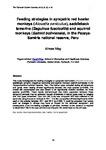Feeding strategies in sympatric red howler monkeys (Alouatta seniculus), saddleback tamarins (Saguinus fuscicollis) and squirrel monkeys (Saimiri boliviensis), in the Pacaya-Samiria national reserve, Peru
| dc.contributor.author | May, A. | |
| dc.date.accessioned | 2019-05-16T09:20:34Z | |
| dc.date.available | 2019-05-16T09:20:34Z | |
| dc.date.issued | 2013 | |
| dc.identifier.citation |
May, A. (2013) 'Feeding strategies in sympatric red howler monkeys (Alouatta seniculus), saddleback tamarins (Saguinus fuscicollis) and squirrel monkeys (Saimiri boliviensis), in the Pacaya-Samiria national reserve, Peru', The Plymouth Student Scientist, 6(2), p. 20-30. | en_US |
| dc.identifier.issn | 1754-2383 | |
| dc.identifier.uri | http://hdl.handle.net/10026.1/14032 | |
| dc.description.abstract |
This study investigated the feeding strategies of sympatric red howlers (Alouatta seniculus), saddleback tamarins (Saguinus fuscicollis) and squirrel monkeys (Saimiri boliviensis) in the Pacaya-Samiria National Reserve, Peru. The habitat types occupied during all behaviours and purely when feeding differed significantly between the three species (p<0.005). The overall diet consumption was also shown to be significantly different between the three species (p<0.005). These results demonstrated that niche separation between these sympatric primates may be achieved through differences in habitat types used for foraging and food types consumed. Data from this study was compared with data collected at the same site using the same methods in 2011. The diet composition differed significantly within each of the species between 2011 and 2012 (p<0.005). It could be proposed that factors such as changes in climate may have an impact on the rainforest ecosystem, and consequently affect the feeding strategies of primates, however further research is required to determine if this is the case and the exact impacts this would have on the primates. | en_US |
| dc.language.iso | en | en_US |
| dc.publisher | University of Plymouth | |
| dc.rights | Attribution 3.0 United States | * |
| dc.rights.uri | http://creativecommons.org/licenses/by/3.0/us/ | * |
| dc.subject | neotropical primates | en_US |
| dc.subject | diet | en_US |
| dc.subject | habitat | en_US |
| dc.subject | niche separation | en_US |
| dc.title | Feeding strategies in sympatric red howler monkeys (Alouatta seniculus), saddleback tamarins (Saguinus fuscicollis) and squirrel monkeys (Saimiri boliviensis), in the Pacaya-Samiria national reserve, Peru | en_US |
| dc.type | Article | |
| plymouth.issue | 2 | |
| plymouth.volume | 6 | |
| plymouth.journal | The Plymouth Student Scientist |



